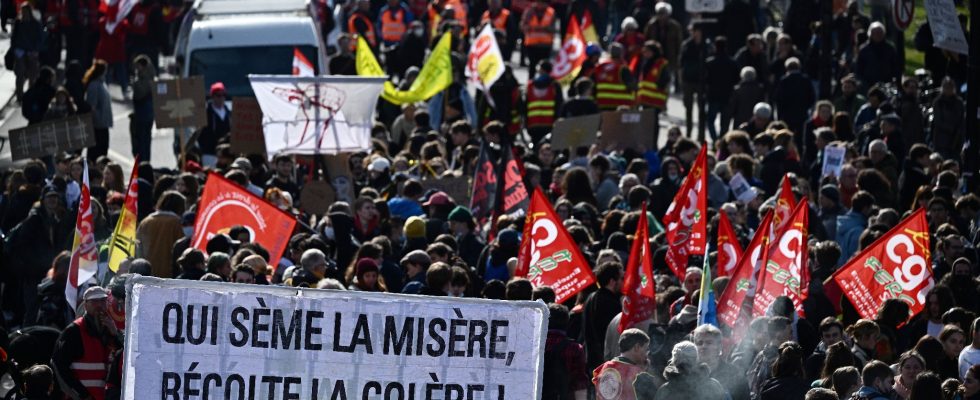Still people in the street but fewer strikers and disturbances? Eight days before the decision of the Constitutional Council on the pension reform, expected on April 14, the unions are organizing this Thursday, April 6, an eleventh day of mobilization. They are hoping for another show of force as talks with the government stall.
On March 28, the previous mobilization had stalled, with according to the Ministry of the Interior 740,000 demonstrators in France, “more than two million” according to the CGT. This time, the authorities expect from police sources between 600,000 and 800,000 people, including 60,000 to 90,000 in Paris where the parade will go from Invalides to Place d’Italie. Some 11,500 police and gendarmes will be mobilized, while the last processions have been marred by tensions.
In the aftermath of a meeting with Elisabeth Borne which ended in “failure” according to the inter-union, users of public transport should not face great difficulties in their travels even if inconveniences are at the rendezvous.
“Almost normal” traffic for the metro and RER in Paris
Traffic is “almost normal” for the metro and the RER in Paris this Thursday, with the exception of a few metro lines, the RATP announced on Wednesday. The Régie plans one in two trains on line 3, as many on line 5 in the morning and one in three in the afternoon, and between one in two and one in three trains between 6 a.m. and 8 p.m. on line 13. others will ride normally. Traffic on line 6, on the other hand, risks being “disturbed by the course of the demonstration scheduled for the afternoon” between the Invalides and the Place d’Italie, warns the RATP.
On the RER network, traffic will be “almost normal” and “normal” on the bus network. Only the RER D remains very disrupted with 40% of the trains maintained. Lines K and R of the Transilien see half of the trains running.
SNCF: three TGVs out of four and one TER out of two on average
SNCF plans to run three out of four TGVs as well as one out of two TERs this Thursday, the public group announced on Tuesday. Traffic is therefore clearly improving compared to previous days, including in Ile-de-France where traffic is almost normal on RER B and where three out of four trains run on RER A.
Intercités traffic, however, remains very disrupted with only a quarter of the trains maintained compared to usual and no night trains. International Eurostar connections to England and Thalys to Benelux are almost normal.
About 20% of strikers in schools
In National Education, around 20% of primary school teachers are on strike, according to the Snuipp-FSU, the leading union in nursery and elementary schools. This estimate is lower than that of the previous day of mobilization, which was 30%.
“We feel that it is becoming more and more complicated for colleagues to strike” because “wage withdrawals are starting to weigh”, leading to “a financial sacrifice”, explained to AFP the general secretary of Snuipp-FSU, Guislaine David. “There is also an expectation of the decision of the Constitutional Council” by the teachers, she added. But “that does not mean that they are not mobilized”, she said, believing that “the minister is above ground when he says that it will not hinder teachers to work two more years”.
Questioned Tuesday on Public Senate on the mobilization of teachers against the pension reform, the Minister of National Education Pap Ndiaye estimated that “teachers were not the spearheads of the mobilization as we could see in the past”. “I think that teachers have made their calculations and realize that the reform as it is proposed has an impact of course, especially for teachers who are at the end of their career, but in proportions that remain relatively manageable” , he added.
On March 28, the Ministry of Education reported 8.37% of striking teachers, including 7.60% in primary education (against 30% estimated by the Snuipp-FSU) and 9.13% in colleges. and high schools (against “around 30%” also counted by the Snes-FSU, the first secondary school union). The highest rate of strikers among teachers dates from January 19, during the first day of action, with 42.35% in primary education and 34.66% in secondary education, according to ministry figures. That day, the unions had identified up to 70% of striking teachers in primary schools and 65% in colleges and high schools.
Fuels: Ile-de-France service stations supplied little by little
The situation should gradually improve for motorists. On Tuesday, the oil group Esso-ExxonMobil announced the restart of production at its refinery in Port-Jérôme-Gravenchon (Seine-Maritime). It was shut down on March 25 for lack of crude oil to be refined due to the strike at the oil terminal in Le Havre against the pension reform.
“The reconstitution of our crude oil stocks and the confirmation of the suspension of the movement at the oil terminal in Le Havre allow us to have sufficient visibility to confirm the restart operations which were launched this afternoon”, indicated to the AFP group management.
The strike was extended there until Thursday, but the strikers agreed last week to sign a protocol with the management, which provides for the release of 43 million liters of fuel from tanks filled to the brim, in order to supply service stations in Ile-de-France.
In the same vein, the neighboring refinery of the TotalEnergies group, in Gonfreville-L’Orcher, the largest in France, has been the subject of employee requisitions by the government and has been shipping fuel to the island since Monday morning. -of France. Most departments in the Paris region are seeing a third of their service stations affected by shortages of super unleaded.
